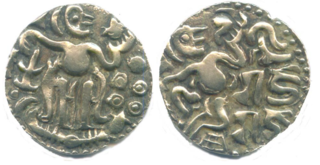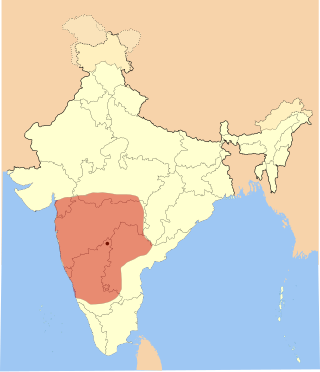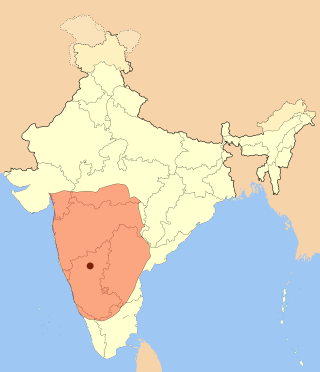
Kulottunga I also spelt Kulothunga, born Rajendra Chalukya, was a Chola Emperor who reigned from 1070 CE to 1122 CE succeeding his cousin Athirajendra Chola. He also served as the Eastern Chalukya king from 1061 CE to 1118 CE, succeeding his father Rajaraja Narendra. He is related to the Chola dynasty through his mother's side and the Eastern Chalukyas through his father's side. His mother, Ammangaidevi, was a Chola princess and the daughter of emperor Rajendra I. His father was king Rajaraja Narendra of the Eastern Chalukya dynasty who was the nephew of Rajendra I and maternal grandson of Rajaraja I. According to historian Sailendra Nath Sen, his accession marked the beginning of a new era and ushered in a period of internal peace and benevolent administration.

Rajadhiraja I was a Chola emperor, the most skilled military commander among the Chola rulers and the successor of his father, Rajendra I. He was the only Chola emperor who was killed while leading his army in war, and although he had a short reign, he helped his father conquer several territories as well as to maintain the Chola authority over most of Sri Lanka, Eastern Chalukya and Kalinga, among others. He also established imperial relations with overseas allies despite a series of revolts in the territory.

The Chola dynasty was a Tamil thalassocratic empire of Tamilakam of Southern India and one of the longest-ruling dynasties in world history. The earliest datable references to the Chola are from inscriptions dated to the 3rd century BCE during the reign of Ashoka of the Maurya Empire. As one of the Three Crowned Kings of Tamilakam, along with the Chera and Pandya, the dynasty continued to govern over varying territories until the 13th century CE. The Chola Empire was at its peak and achieved imperialism under the Medieval Cholas in the mid-9th century CE. Related dynasties are Telugu Chodas of Andhra, Chodagangas of Kalinga, Nidugal Cholas of Karnataka, Rajahnate of Cebu, Rajahnate of Sanmalan.

Avani is a small village in Mulabaagilu taluk, Kolara district in Karnataka, India, about ten miles from Kolar Gold Fields. The village is located at 32 km from Kolara, the district centre and 13 km from Mulabaagilu, the Taluk headquarters. It is a popular location for rock climbing.

Western Ganga was an important ruling dynasty of ancient Karnataka in India which lasted from about 350 to 1000 CE. They are known as "Western Gangas" to distinguish them from the Eastern Gangas who in later centuries ruled over Kalinga. The general belief is that the Western Gangas began their rule during a time when multiple native clans asserted their freedom due to the weakening of the Pallava empire in South India, a geo-political event sometimes attributed to the southern conquests of Samudra Gupta. The Western Ganga sovereignty lasted from about 350 to 550 CE, initially ruling from Kolar and later, moving their capital to Talakadu on the banks of the Kaveri River in modern Mysore district.
Parantaka Chola II was a Chola emperor. He is also known as Sundara Chola as he was considered an epitome of male beauty. He was the son of Arinjaya Chola and queen Kalyani, a princess of Vaidumba family. Parantaka II ascended the Chola throne despite the fact that his cousin Madurantaka Uttama Chola, the son of Gandaraditya Chola(the elder brother of Arinjaya Chola) was alive and he had equal if not more claim to the Chola throne. During his reign, Parantaka Sundara Chola defeated the Pandyas and Ceylon and then recaptured the Tondaimandalam from Rashtrakutas.
Athirajendra Chola reigned for a very short period of few months as the Chola king succeeding his father Virarajendra Chola. His reign was marked by civil unrest, possibly religious in nature. Athirajendra Chola was last clan of Chola dynasty. He was killed in the religious chaos. Athirajindra and Virarajendra Chola interfered in the Vengi succession disputes after the Vengi king Rajaraja Narendra, who was closely related to the Chola clan through his mother Kundavai, a daughter of Rajaraja Chola, died in 1061 CE. The Vengi throne went to Saktivarman II in a palace coup. The Cholas wanted the Chola influence re-established in Vengi. Saktivarman II was killed, but Vijayaditya, Saktivarman's father assumed the throne and repulsed the Chola attempts at unseating him. Vijayaditya however accepted to serving as a Chola vassal.

The Telugu Chodas or Telugu Cholas ruled parts of present-day Andhra Pradesh between the sixth and the thirteenth century as subordinates of Pallavas and later under Chola dynasty. The earliest Choda family in the Telugu area was that of Renati Chodas, which claimed descent from Karikala Chola. Other Choda dynasties include Velanati, Pottapi, Konidena, Nannuru, Nellore etc.

Eastern Chalukyas, also known as the Chalukyas of Vengi, were a dynasty that ruled parts of South India between the 7th and 12th centuries. They started out as governors of the Chalukyas of Badami in the Deccan region. Subsequently, they became a sovereign power, and ruled the Vengi region of present-day Andhra Pradesh until c. 1001 CE. They continued ruling the region as feudatories of the Medieval Tamil Cholas until 1189 CE.

Tailapa II, also known as Taila II and by his title Ahavamalla, was the founder of the Western Chalukya dynasty in southern India. Tailapa claimed descent from the earlier Chalukyas of Vatapi, and initially ruled as a Rashtrakuta vassal from the Tardavadi-1000 province in the modern Bijapur district of Karnataka. When the Rashtrakuta power declined following an invasion by the Paramara king Siyaka, Tailapa overthrew the Rashtrakuta king Karka II, and established a new dynasty.

The Western Chalukya Empire ruled most of the western Deccan, South India, between the 10th and 12th centuries. This Kannadiga dynasty is sometimes called the Kalyani Chalukya after its regal capital at Kalyani, today's Basavakalyan in the modern Bidar District of Karnataka state, and alternatively the Later Chalukya from its theoretical relationship to the 6th-century Chalukya dynasty of Badami. The dynasty is called Western Chalukyas to differentiate from the contemporaneous Eastern Chalukyas of Vengi, a separate dynasty. Prior to the rise of these Chalukyas, the Rashtrakuta empire of Manyakheta controlled most of Deccan and Central India for over two centuries. In 973, seeing confusion in the Rashtrakuta empire after a successful invasion of their capital by the ruler of the Paramara dynasty of Malwa, Tailapa II, a feudatory of the Rashtrakuta Dynasty ruling from Bijapur region defeated his overlords and made Manyakheta his capital. The dynasty quickly rose to power and grew into an empire under Someshvara I who moved the capital to Kalyani.

Krishna III whose Kannada name was Kannara was the last great warrior and able monarch of the Rashtrakuta dynasty of Manyakheta. He was a shrewd administrator and skillful military campaigner. He waged many wars to bring back the glory of the Rashtrakutas and played an important role in rebuilding the Rashtrakuta empire. He patronised the famous Kannada poets Sri Ponna, who wrote Shanti purana, Gajankusha, also known as Narayana, who wrote on erotics, and the Apabhramsha poet Pushpadanta who wrote Mahapurana and other works. His queen was a Chedi princess and his daughter Bijjabbe was married to a Western Ganga prince. During his rule he held titles such as Akalavarsha, Maharajadhiraja, Parameshvara, Paramamaheshvara, Shri Prithvivallabha etc. At his peak, he ruled a vast empire stretching from the Narmada river in the north to the Kaveri river delta in the south. A copper grant of 993 issued by the Shilahara king of Thana claims the Rashtrakuta control extended from the Himalayas in the north to Ceylon in the south and from the eastern sea to the western seas. The grant states that when King Krishna III mobilised his armies, the kings of Chola, Bengal, Kannauj, Andhra and Pandya regions used to quiver.

The recorded history of Andhra Pradesh, one of the 28 states of 21st-century India, begins in the Vedic period. It is mentioned in Sanskrit epics such as the Aitareya Brahmana. Its sixth-century BCE incarnation Assaka lay between the Godavari and Krishna Rivers, one of sixteen mahajanapadas. The Satavahanas succeeded them, built Amaravati, and reached a zenith under Gautamiputra Satakarni.
The Western Ganga Dynasty ruled large parts of southern Karnataka from the fourth century CE till the late tenth century CE with their regal capital initially at Kolar and later at Talakad in Mysore district, Karnataka. The origin of the Ganga clan prior to the fourth century is shrouded in legends and myths. Clarity into their history comes from such contemporaneous writings as Chavundaraya Purana in Kannada and Lokhavibhaga in Prakrit and from numerous inscriptions excavated in the Mysore, Bangalore and Kolar districts and Anantapur district. The Western Gangas played a pivotal role in the development of polity, culture and literature during their long rule in the region, at times as independent monarchs and at other times as subordinates of their larger neighbors: the Badami Chalukyas and later the Rashtrakutas of Manyakheta. Their patronage to literature in Kannada and Sanskrit, their achievements in architecture including the famous monolith of Gomateshwara, their Hindu temples in the southern Karnataka, and their Jain Basadi's of Shravanabelagola and Kambadahalli are testimony to the rich contribution they made to the region.
The Nolamba dynasty the area they held sway over is referred to as Nolambasa-37 of Henjeru (Hemavathi), Nolambalige (Nolambavadi-32000), etc. R. Narasimhacharya states that the Nolambas were a native Kannada dynasty.

Rajaditya Chola was a Chola prince, son of king Parantaka I and a Chera/Kerala princess, known for commanding the Chola troops in the battle of Takkolam (948–949).

The Chalukya dynasty was a Classical Indian dynasty that ruled large parts of southern and central India between the 6th and the 12th centuries. During this period, they ruled as three related yet individual dynasties. The earliest dynasty, known as the "Badami Chalukyas", ruled from Vatapi from the middle of the 6th century. The Badami Chalukyas began to assert their independence at the decline of the Kadamba kingdom of Banavasi and rapidly rose to prominence during the reign of Pulakeshin II. After the death of Pulakeshin II, the Eastern Chalukyas became an independent kingdom in the eastern Deccan. They ruled from Vengi until about the 11th century. In the western Deccan, the rise of the Rashtrakutas in the middle of the 8th century eclipsed the Chalukyas of Badami before being revived by their descendants, the Western Chalukyas, in the late 10th century. These Western Chalukyas ruled from Kalyani until the end of the 12th century.
Perumbanappadi was the original home of the historic Bana Chieftains of the early Pallava period. It extended from the South Pennar to the Tirupati (Thirumala) hills. Perumbanappadi was made up of sub-divisions such as the Thiruvenkata-Kottam, and many Nadus such as Tuy-nadu, Puli-nadu, Vada Pulinadu, and Silai-nadu within it. During the Chola period, Perumbanappadi was a major division of the Jayakonda Chola Mandalam. and also represented the north-western portions of Thondai-Mandalam.
Kundhavai was a historic and a popular name of a number of royal women in southern India between the ninth and eleventh century. Some of the women who went by the name Kundavai are as follows:
The Battle of Takkolam (948–949) was a military engagement between a contingent of troops led by Rajaditya, crown prince and eldest son of the Chola king Parantaka I (907–955), and another led by the Rashtrakuta king Krishna III (939–967) at Takkolam in southern India. The battle resulted in the death of Rajaditya on the battlefield and the defeat of the Chola garrison at Takkolam.













